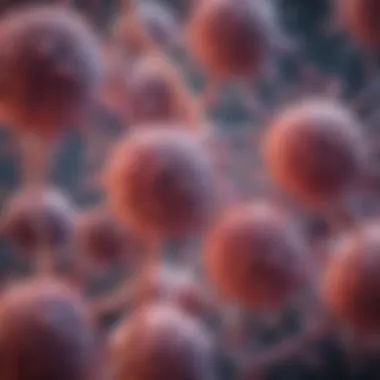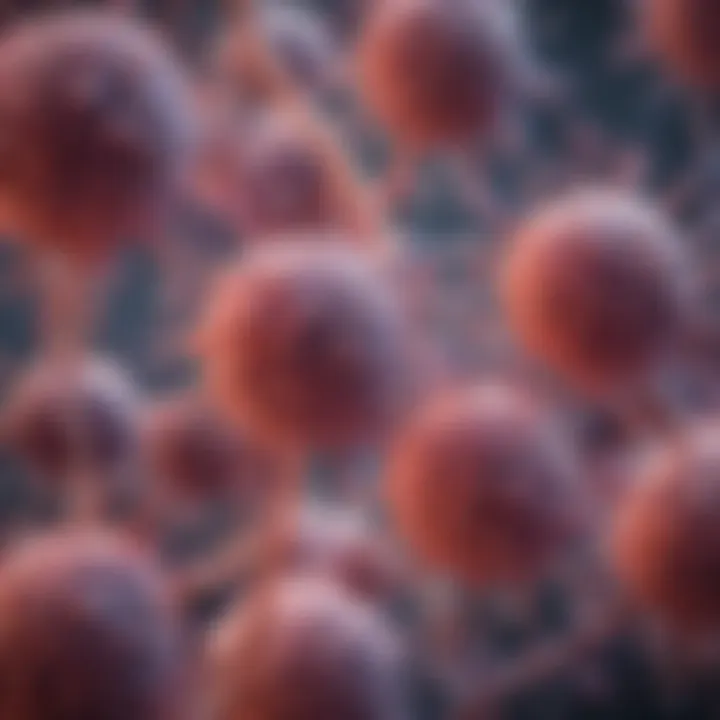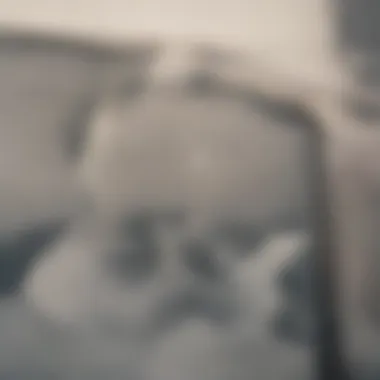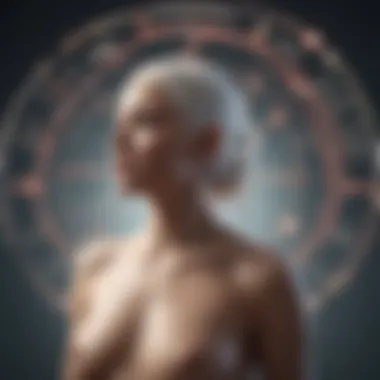Historical and Modern Perspectives on Cancer Cures


Intro
The quest for a cancer cure is a complex journey spanning centuries. From ancient remedies to modern scientific breakthroughs, the narrative is filled with evolving understandings and technological advancements. This exploration not only considers historical perspectives but also evaluates current methodologies and the definitions of what it means to attain a 'cure.' By examining these facets, one can appreciate the multifaceted nature of oncology and the ongoing battle against this set of diseases.
Recent Advances
Understanding recent advances is crucial as they reflect progress in the field of oncology. The landscape of cancer treatments has changed dramatically in recent years, driven by research and innovation. This section will outline two significant aspects of these advancements:
Latest Discoveries
Recent discoveries in the realm of cancer research have unveiled new pathways for treatment. For instance, immunotherapy has emerged as a promising approach, harnessing the body's immune system to combat cancer cells more effectively. Key drugs like pembrolizumab and nivolumab have shown notable success in treating melanoma and lung cancer.
Another finding is the identification of genetic mutations that contribute to the risk of certain cancers. Clinical trials involving targeted therapies, such as trastuzumab for breast cancer linked to the HER2 gene, show how personalized medicine is paving the path towards specific and more effective treatments.
Technological Innovations
Technological innovations play a vital role in cancer research and treatment. Advanced imaging techniques, like PET scans and MRI, have improved the precision of diagnoses. These tools allow oncologists to identify tumors early and assess their development, enhancing the chances of successful intervention.
Moreover, developments in machine learning and artificial intelligence are now being incorporated into treatment strategies. This integration helps in analyzing vast datasets, predicting patient outcomes, and personalizing therapeutic approaches based on individual profiles.
"The future of oncology relies on a blend of technology and biology to achieve optimal patient outcomes."
Methodology
To grasp the diverse approaches to studying cancer cures requires understanding the methodologies that underpin research and analysis. This section will delve into two essential components:
Research Design
Research on cancer cures often adopts designs that allow for both qualitative and quantitative analysis. Clinical trials serve as the cornerstone of this research, rigorously testing new treatments while adhering to safety protocols. Observational studies also contribute valuable data, highlighting real-world implications and patient experiences with existing therapies.
Data Collection Techniques
Effective data collection techniques are paramount. Surveys and questionnaires provide insights into patient-reported outcomes and quality of life assessments. Additionally, biospecimen collections during surgeries or treatments enable scientists to study cancer at a molecular level, potentially revealing critical biomarkers.
In summary, the examination of cancer cures demands attention not only to historical context but also to current advancements. By synthesizing the progress in research methodologies and the latest insights, we can better appreciate the complexities surrounding cancer treatment and the ongoing quest for a definitive cure.
Prologue
The topic of cancer cures holds immense significance, not only in the field of medicine but also in public health discussions. The evolving understanding of cancer, coupled with historical treatments and contemporary perspectives, informs how society views this disease and its management. This article aims to dissect not just what a cancer cure means but also how the definitions have shifted over time. By exploring this complexity, readers can gain a nuanced understanding of the current frameworks and approaches in cancer treatment.
Cancer is not a single disease but rather a group of diseases characterized by uncontrolled cell growth. This complexity adds to the difficulty of finding a definitive cure. The multifaceted nature of cancer provides both challenges and opportunities for research and innovation in therapeutic methodologies. Various factors, including genetic diversity, environmental influences, and individual health, contribute to how cancer manifests and responds to treatment.
Moreover, as research continues, new treatments and technologies emerge, raising questions about the terminology we use. Words like "remission" and "cure" carry different implications for patients and the medical community. With advancements in personalized medicine and targeted therapies, the traditional concepts may need reevaluation.
In this article, the journey of cancer treatment will unfold. The historical context will be established, paving the way for understanding current approaches. By examining these elements, a clearer picture of the persistent challenge in the quest for a cancer cure will come into focus. The insights shared aim to educate students, researchers, educators, and professionals who are keen to explore this critical area of study.
Defining Cancer and Its Complexity
To appreciate the intricacies involved in finding a cancer cure, it is necessary first to define what cancer is. Cancer arises from the body's own cells, which can mutate and begin to grow uncontrollably. This can lead to the formation of tumors, which may be benign or malignant. The malignant tumors can invade nearby tissues and spread to other parts of the body through the bloodstream or lymphatic system.
The variability in cancer types—such as breast, lung, prostate, and skin cancer—highlights its complexity. Each cancer type possesses unique characteristics and behaviors, demanding tailored approaches to treatment. For example, lymphoma is treated differently than melanoma. Even within these categories, there exists a broad spectrum of subtypes, each presenting its own challenges in terms of prognosis and response to therapy.
"Understanding the complexity of cancer is crucial for developing effective treatments that cater to individual needs."


Cancer's genetic landscape adds another layer of difficulty. Genetic mutations can affect how cancer develops and responds to treatments. Most cancers are not the result of a single mutation; they are driven by a combination of genetic and epigenetic changes that occur over time. This makes finding a one-size-fits-all cure complicated.
Additionally, the psychosocial aspects of cancer contribute to its complexity. Patients often experience emotional, social, and financial burdens that influence their treatment pathways and overall quality of life. The stigma and varying perceptions surrounding cancer further complicate its management.
Ultimately, defining cancer transcends simple medical terminology; it involves an interdisciplinary understanding that incorporates biology, psychology, and social dynamics. Without fully grasping this complexity, the pursuit of a definitive cure risks oversimplification, hindering progress toward effective solutions.
Historical Overview of Cancer Treatments
The historical overview of cancer treatments is essential in understanding the evolving landscape of oncology. This section highlights significant milestones, methodologies, and philosophical shifts that have influenced how society perceives and treats cancer. By examining past approaches, we can appreciate contemporary advancements and recognize the ongoing challenges that persist in locating an effective cure.
Ancient Approaches to Cancer Management
Historically, cancer was often perceived through a mystical lens, lacking the scientific rigor applied today. Ancient societies employed various methods to address tumors. Ancient Egyptians utilized natural remedies, such as herbs and surgical practices described in the Edwin Smith Papyrus. This document illustrates that some understanding of anatomy and tumors existed in that era. They also employed aggressive techniques, like cauterization.
In ancient Greece, Hippocrates referred to cancer as "karkinos", meaning crab, due to its characteristic appearance. He proposed numerous theories, such as the imbalance of bodily humors, which held that an equilibrium of fluids influenced health and disease. Treatments varied from lifestyle changes to herbal remedies.
The Roman culture continued this legacy by documenting cancer cases more systematically. Galen's contributions were notable; he theorized that tumors were formed from sanguineous tissue. These views provided a foundation, although flawed, for future medical understanding.
Advancements in the 20th Century
By the 20th century, scientific advancements catalyzed a profound shift in cancer treatment. The development of anesthesia and asepsis transformed surgical interventions. Surgeons began to perform more invasive procedures with heightened success rates. Notably, radical mastectomy became mainstream under the guidance of physician William Halsted. This aggressive surgical option was initially thought to minimize recurrence of breast cancer and paved the way for later, less invasive techniques.
Simultaneously, the introduction of chemotherapy revolutionized the cancer treatment landscape. In the 1940s, the use of nitrogen mustards, originally developed as chemical warfare agents, provided a new mechanism to attack cancer cells. This marked the beginning of combining surgery with systemic treatments.
Radiation therapy also gained prominence during this period. Initially used for diagnostic purposes, its therapeutic applications expanded rapidly. The discovery of X-rays by Wilhelm Röntgen and their subsequent use to target malignancies marked a transformative era in cancer care.
These advancements were not without drawbacks. Potential side effects of chemotherapy and radiation became apparent, leading to further investigation into the biological responses of cancer. Research during this century laid crucial groundwork for understanding cancer biology, leading to better-targeted treatments and paved the way for the promise of personalized medicine down the line.
The Concept of a Cure
The concept of a cure is essential in understanding the ongoing battle against cancer. Defining a cure for cancer has both medical and emotional implications. This definition can shape patient experiences, treatment guidelines, and societal perceptions surrounding cancer.
Cures and responses to cancer can be distinct. Individuals diagnosed with cancer often hope not just for treatment but also a definitive resolution. As such, precise terminology plays a role in both clinical settings and how patients perceive their prognosis. Understanding what constitutes a cure can guide patients and practitioners alike, allowing for informed decisions about treatment approaches.
What Constitutes a Cure for Cancer?
A cure for cancer generally refers to the complete eradication of cancer from the body, where the disease does not return after treatment. However, this definition is not simple. Factors like the type of cancer, its stage, and the patient’s overall health can all influence what a cure looks like.
In medical literature, criteria for a cure can include:
- Complete Response: No signs or symptoms of cancer can be detected.
- Durability: Patients remain cancer-free for a set period, often five years after the initial diagnosis.
- Quality of Life: Maintaining a high quality of life post-treatment can also indicate a successful cure.
Moreover, some cancers are characterized by prolonged remissions rather than definitive cures, complicating the definition further. An example is chronic lymphocytic leukemia, which may not have a straightforward cure but can be controlled for years.
Remission vs. Cure: A Distinction
Understanding the difference between remission and a cure is vital. Remission indicates a reduction or disappearance of disease signs, while a cure implies total eradication.
- Remission: A patient may experience a temporary absence of disease symptoms or sign. In some cases, remission can be partial or complete.
- Cure: The ongoing absence of disease for a significant time without recurrence is viewed as a cure.
While remission indicates that treatments are effective, it does not guarantee a lifetime free of cancer. This distinction is crucial for patients when setting expectations and understanding their treatment journey.
"The lack of clarity between remission and cure can lead to confusion and sometimes, misplaced hope. It is paramount for healthcare professionals to communicate these meanings effectively, ensuring patients grasp their health statuses."


The complexities surrounding the concept of a cure require careful examination. Despite advances in research and treatment, defining a cure remains a nuanced and pivotal conversation in oncology.
Current Treatments and Research
The realm of cancer treatments is vast and constantly evolving. Understanding the current methodologies used in cancer care is crucial for grasping how we address this multifaceted disease. This section outlines several key approaches to treating cancer, emphasizing their significance, innovations, and the considerations involved in each treatment modality.
Surgical Interventions
Surgical intervention remains a cornerstone in cancer treatment, primarily focused on removing tumors from the body. The effectiveness of surgery largely hinges on the type and stage of cancer. For localized cancers, surgery can offer the highest potential for a cure. During the procedure, surgeons aim to excise not just the tumor but also a margin of healthy tissue to minimize the risk of recurrence.
However, surgery is not devoid of challenges. The physical impact on patients and the possibility of complications are critical factors. Moreover, not all patients are eligible for surgical options due to various health considerations or cancer stages. In such cases, a multimodal approach, incorporating other treatment methods, may be adopted.
Chemotherapy: Mechanisms and Efficacy
Chemotherapy employs drugs to target rapidly dividing cancer cells. The mechanism primarily involves disrupting cellular processes that enable cancer growth. While it can effectively shrink tumors or eradicate cancer cells, it also impacts healthy cells, which leads to side effects like nausea and hair loss.
The efficacy of chemotherapy is influenced by several factors, such as the cancer type and patient health. Ongoing research focuses on understanding resistance mechanisms. This effort aims to develop personalized treatment plans that adjust drug combinations to enhance effectiveness and reduce adverse effects. In essence, chemotherapy’s role is vital but must be balanced with its potential downsides.
Radiation Therapy: Therapeutic Applications
Radiation therapy uses high-energy particles or waves to destroy cancer cells or inhibit their growth. This method is often employed in conjunction with surgery or chemotherapy. Radiation can be particularly beneficial for localized cancers or to manage symptoms in advanced cases.
There are two main types: external beam radiation and brachytherapy. Each has distinct applications and side effects. For instance, while external beam radiation targets tumors from outside the body, brachytherapy involves placing radioactive material inside or near the tumor. Research continues to optimize dosages and delivery methods to maximize tumor control while mitigating collateral damage to surrounding tissues.
Emerging Biological Therapies
The field of cancer treatment is increasingly incorporating biological therapies, including immunotherapy and targeted therapies. Immunotherapy harnesses the body’s immune system to fight cancer. This approach can involve checkpoint inhibitors, CAR T-cell therapy, and vaccines. On the other hand, targeted therapies focus on specific genetic markers or mutations within cancer cells, disrupting their growth signals.
Both therapy types demonstrate significant promise, particularly in treating cancers that do not respond well to traditional methods. As research advances, the goal is to refine these therapies further, minimizing side effects and enhancing patient outcomes. These therapies represent a shift towards precision medicine, where treatments are tailored to individual patients based on their cancer characteristics.
"The future of cancer treatment lies in personalized strategies that evolve with our understanding of the disease at the molecular level."
The interplay of these approaches outlines the importance of continued research in optimizing treatments and improving patient care. By understanding current treatments and emerging therapies, we lay the groundwork for more effective solutions in the ongoing battle against cancer.
Challenges in Finding a Cure
The quest for a definitive cancer cure embodies a complex landscape of scientific, medical, and socio-cultural challenges. Understanding these obstacles is essential for grasping why a universal cure for cancer remains elusive. Each challenge presents not just barriers to treatment, but also opportunities for advancing our knowledge and refining our approaches. Acknowledging these difficulties allows researchers and practitioners to develop more tailored strategies to combat different forms of cancer effectively.
Genetic Diversity of Cancer
Cancer is not a single disease. It encompasses a multitude of conditions characterized by uncontrolled cell growth. The genetic diversity among tumors is a significant hurdle in finding a universally effective cure. Each cancer type, and even each tumor within a type, can exhibit distinct mutations, making a one-size-fits-all treatment approach impractical. Researchers have identified numerous genes related to cancer proliferation, such as the BRCA1 and TP53 genes. These mutations can influence how a tumor responds to therapies, emphasizing the need for personalized medicine.
- Variability in Response: Individuals may exhibit varying responses to the same treatment due to genetic differences. This variability complicates the identification of effective therapies.
- Targeting Mutations: Identifying specific mutations within a tumor can guide targeted therapies, such as those that inhibit particular signaling pathways. However, this requires sophisticated diagnostic tools and a deep understanding of cancer genetics.
- Potential for Resistance: Tumors can evolve, acquiring new mutations that confer resistance to therapies previously effective. This adaptability renders initial successful treatments ineffective over time.
Metastasis and Its Implications
Metastasis, the process by which cancer cells spread to distant parts of the body, poses another formidable challenge in cancer treatment. When cancer metastasizes, it changes in its biological behavior and can become more aggressive and resistant to standard treatments. Understanding metastasis is critical for developing new therapeutic strategies.
- Complex Biology: Metastatic cancer cells often behave differently than primary tumor cells, complicating treatment approaches. These changes can involve alterations in gene expression that allow cancer cells to invade surrounding tissues and establish secondary tumors.
- Treatment Resistance: Metastatic cells frequently demonstrate resistance to chemotherapy and radiation, leading to poor patient outcomes. Research is ongoing to find treatments that can effectively target these cells without harming normal cells.
- Surveillance of Metastasis: Effective surveillance methods are needed to detect metastasis early. Current imaging techniques have limitations, and more sensitive methods are required to monitor tumor progression, particularly in high-risk patients.
Resistance to Treatment
Resistance to cancer treatment is a critical issue that complicates the pursuit of a cure. There are two primary types of resistance: intrinsic resistance, where tumors do not respond to therapy from the outset, and acquired resistance, where tumors initially respond to treatment but eventually do not.


- Biological Mechanisms: Tumors may employ various biological mechanisms to resist treatment. For example, they can alter drug targets, reduce drug uptake, or increase drug-efflux mechanisms, enabling them to survive against therapeutic agents.
- Pathway Redundancy: Cancer cells may activate alternative pathways that allow them to bypass targeted therapies. This redundancy means that blocking one pathway might not be sufficient to eradicate the cancer, necessitating combination therapy approaches.
- Monitoring and Adapting Treatments: Adaptive treatment strategies are essential. Continuous monitoring of tumor response can guide alterations in therapy, potentially preventing or overcoming resistance. Research in pharmacogenomics is critical to understanding how individual genetic variations can affect treatment outcomes and tailor therapies accordingly.
"Understanding the intricacies of cancer genetics, the behavior of metastatic cells, and the mechanisms of treatment resistance is pivotal to improving therapeutic outcomes for patients."
Cultural and Social Aspects of Cancer Treatment
The cultural and social aspects of cancer treatment play a significant role in how society approaches, understands, and reacts to cancer. These aspects influence treatment choices, the support systems available to patients, and the overall effectiveness of methods administered. Understanding these elements is critical for comprehending the effectiveness of cancer care and for fostering an environment conducive to research and treatment. In this section, we will explore societal perceptions of cancer and the stigmas attached to cancer research, highlighting the complexity surrounding this disease.
Perceptions of Cancer in Society
Cancer evokes a myriad of responses in society, heavily shaped by cultural, educational, and individual biases. Many people still associate cancer with death, which can lead to fear and misinformation. This fear often results in individuals delaying treatment or avoiding medical consultation. Moreover, cultural beliefs may lead some to prefer alternative therapies over conventional medicine, potentially compromising treatment outcomes.
A study published in JAMA Oncology indicated that cultural beliefs significantly impact health-seeking behavior in certain populations. The stigma associated with cancer can also create a barrier for open discussions, further isolating individuals diagnosed with the disease. On the other hand, societies that have fostered open dialogue about cancer have seen better community support networks, leading to improved patient outcomes. Encouraging transparency and education around cancer can shift the societal perception from fear to one of empowerment and support.
Stigmas Surrounding Cancer Research
Stigmas related to cancer research can complicate the quest for a cure or better treatments. Some individuals harbor misconceptions about the safety and efficacy of treatments that are under investigation. This can foster skepticism towards clinical trials, which are essential for advancing cancer treatments. Many patients may fear being viewed as ‘guinea pigs’ and thus shy away from participating in these critical studies.
Additionally, there can be societal stigmas tied to specific types of cancer. For instance, cancers linked to lifestyle choices, such as lung cancer from smoking, can result in blame directed at patients. This stigma can hinder individuals from seeking help or participating in discussions about prevention, care, and research.
"Addressing these stigmas through education and open discussions is paramount in converging public perceptions and promoting participation in research."
In summary, the cultural and social aspects of cancer treatment are pivotal in shaping public perception and acceptance of therapies. Addressing misconceptions and eliminating stigma associated with both cancer itself and the research surrounding it are essential steps toward enhancing treatment outcomes and encouraging a more supportive environment for those affected by this complex disease.
Future Directions in Cancer Research
Future directions in cancer research are crucial for understanding how we can improve treatment, management, and, ultimately, outcomes for patients facing cancer. With advancements in both scientific knowledge and technology, the potential to reshape oncology practices is immense. This section explores two critical aspects of future cancer research: personalized medicine and technological innovations in cancer detection.
Advancements in Personalized Medicine
Personalized medicine represents a paradigm shift in how cancer is treated. This approach focuses on tailoring treatment based on individual patient characteristics, including genetics, tumor biology, and lifestyle. One key benefit of personalized medicine is its potential to increase the efficacy of treatments while minimizing side effects. By understanding the specific genetic mutations that drive a person's cancer, oncologists can select targeted therapies that are more likely to succeed.
For instance, medications like trastuzumab are effective for patients with HER2-positive breast cancer. Similarly, next-generation sequencing has become a cornerstone of personalized medicine. It allows for a comprehensive analysis of a tumor's genetic makeup, uncovering mutations that inform therapy choices, whether through targeted inhibitors or immunotherapies. This unique focus on the individual not only enhances the treatment outcome but also transforms the patient experience, allowing them to have a more proactive role in their care.
Moreover, ongoing research is imperative. Clinical trials integrating personalized approaches can further understand how treatments affect diverse populations. The challenge lies in the complexity of tumor heterogeneity and the need for a robust infrastructure to analyze vast amounts of genetic data.
Role of Technology in Cancer Detection
Technological innovations play an increasingly significant role in the early detection of cancer. Early diagnosis critically influences treatment success and can significantly improve survival rates. Advanced imaging techniques, such as PET scans and MRI, allow for earlier and more precise detection of tumors. These modalities provide detailed insights into the size and location of tumors, aiding in treatment planning.
In addition to imaging, liquid biopsy offers a non-invasive method to detect cancer-related biomarkers. By analyzing circulating tumor DNA or RNA in the bloodstream, physicians can identify the presence of cancer much earlier than traditional biopsy methods would allow. This method has the potential to guide treatment decisions and monitor responses over time.
"The future of cancer research is not just about finding new treatments, but finding the right treatment for the right person at the right time."
Culmination
The examination of cancer cures is both timely and crucial in the landscape of medical research and patient care. This article has traversed a plethora of perspectives surrounding cancer treatment, revealing the complexities involved in defining what constitutes a cure. The relentless quest for a cancer cure derives not only from clinical interest but also from the hope and expectation of patients and families affected by this disease.
The Persistent Pursuit of a Cancer Cure
The pursuit of a cancer cure remains a central focus for oncologists and researchers alike. Understanding cancer as a collection of diseases rather than a single entity complicates this search. Each type of cancer has unique characteristics, presenting differential challenges in treatment and management. As highlighted throughout the article, examining historical and contemporary approaches reveals ongoing evolution in therapeutic strategies.
One significant aspect of this ongoing quest is the promise of personalized medicine. Tailoring treatment based on individual genetic profiles and tumor characteristics leads to more effective interventions. This advancement in cancer research contributes to hopefulness in what was once considered an insurmountable struggle.
Here are a few key considerations regarding the ongoing journey towards a cancer cure:
- Continued Research Funding: Investment in oncology research is essential for breakthroughs in treatment.
- Public Awareness and Education: Increasing knowledge about the disease promotes earlier diagnosis and better treatment options, which can enhance patient outcomes.
- Collaboration Across Disciplines: Cooperation among researchers and institutions promotes innovative solutions and accelerates the pace of discovery.
"Understanding cancer's complexity is pivotal in defining the future of treatment and ultimately finding a cure."
While significant progress has been made, the journey is far from complete. There will always be new challenges to overcome, including drug resistance and the need for effective treatment for rare cancers. The persistent pursuit of a cancer cure, therefore, remains an intricate blend of hope, vigilance, and relentless inquiry into the depths of human health and disease.















